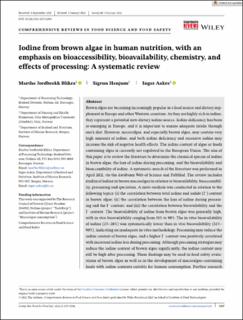Iodine from brown algae in human nutrition, with an emphasis on bioaccessibility, bioavailability, chemistry, and effects of processing: A systematic review
Peer reviewed, Journal article
Published version
Date
2022Metadata
Show full item recordCollections
- Articles [3011]
- Publikasjoner fra CRIStin [3061]
Original version
Comprehensive Reviews in Food Science and Food Safety. 2022, 21 (2), 1517-1536. 10.1111/1541-4337.12918Abstract
Brown algae are becoming increasingly popular as a food source and dietary supplement in Europe and other Western countries. As they are highly rich in iodine, they represent a potential new dietary iodine source. Iodine deficiency has been re-emerging in Europe, and it is important to ensure adequate intake through one's diet. However, macroalgae, and especially brown algae, may contain very high amounts of iodine, and both iodine deficiency and excessive iodine may increase the risk of negative health effects. The iodine content of algae or foods containing algae is currently not regulated in the European Union. The aim of this paper is to review the literature to determine the chemical species of iodine in brown algae, the loss of iodine during processing, and the bioavailability and bioaccessibility of iodine. A systematic search of the literature was performed in April 2021, via the databases Web of Science and PubMed. The review includes studies of iodine in brown macroalgae in relation to bioavailability, bioaccessibility, processing and speciation. A meta-analysis was conducted in relation to the following topics: (i) the correlation between total iodine and iodide (I–) content in brown algae; (ii) the correlation between the loss of iodine during processing and the I– content; and (iii) the correlation between bioavailability and the I– content. The bioavailability of iodine from brown algae was generally high, with in vivo bioavailability ranging from 31% to 90%. The in vitro bioavailability of iodine (2%–28%) was systematically lower than in vivo bioavailability (31%–90%), indicating an inadequate in vitro methodology. Processing may reduce the iodine content of brown algae, and a higher I– content was positively correlated with increased iodine loss during processing. Although processing strategies may reduce the iodine content of brown algae significantly, the iodine content may still be high after processing. These findings may be used in food safety evaluations of brown algae as well as in the development of macroalgae-containing foods with iodine contents suitable for human consumption. Further research on processing techniques to reduce the iodine content in brown macroalgae are warranted. Iodine from brown algae in human nutrition, with an emphasis on bioaccessibility, bioavailability, chemistry, and effects of processing: A systematic review
